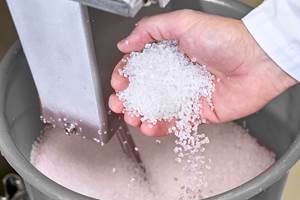New Materials and Methods for Optical Discs
The so-called “format war” has finally hit the streets.
The so-called “format war” has finally hit the streets. Movies are now available for purchase on competing versions of new higher-density DVD formats: Several titles on HD-DVD appeared in April, and rival Blu-ray discs are expected on store shelves this month. These discs up the ante on data capacity to 15 GB for a single-layer HD-DVD and 25 GB for a single-layer Blu-ray disc. (Dual layers could provide up to 50 GB per disc.) For now, the two formats will coexist in the marketplace.
So far, HD-DVD manufacturing involves no major departure from previous technology. But for Blu-ray, major changes in substrate material and coating procedures are being closely evaluated. While specs for Blu-ray discs were announced in January, the decision on how to make discs that meet those specs is up to the replicators, according to Gordon Van Dyke, technical manager for data storage at GE Plastics.
New choice of substrate
GE is developing a substrate for Blu-ray discs based on its Noryl PPO/polystyrene alloy rather than traditional polycarbonate. Noryl has never been used before in optical discs. One reason is that Noryl is opaque. Up to now, the plastic substrate had to be transparent to red laser light. But the blue laser that gives Blu-ray its name does not need to read through the substrate.
Polycarbonate disc substrates typically require a moisture-barrier layer and lacquer coating. Unlike PC, Noryl has low water absorption and also higher stiffness, notes Van Dyke. That eliminates need for secondary coatings and associated process steps. Noryl discs reportedly have much better dimensional stability and tend not to warp or tilt. “A simpler process leads to better yields,” says Steve Wyatt, GE’s global marketing director. GE brought out dedicated grades of Noryl during the first quarter of 2006.
Spin coat or laminate?
GE is also offering a new and simpler approach to protective coatings for Blu-ray discs. GE has ample experience with hard coatings at GE Advanced Materials, Silicones . Says Wyatt, “We developed a spin-coat resin that not only has hard-coat capability but also the anti-fingerprint properties mandated for recordable Blu-ray formats.” With hard-coat and anti-fingerprint functionality in one coating, the need for extra process steps is further reduced.
Degussa AG in Germany advocates a very different approach—film lamination instead of spin coating. Film lamination, a technique that has long been considered but never used for optical discs, prompted renewed attention when Singulus, Philips, and Sony reportedly told Degussa that spin coating is troublesome if you want to make a 100-micron-thick layer. Says Herbert Groothues, product-line director for optoelectronics in the High Performance Polymers ┤¾¤¾┤½├¢ unit, “Problems arise with thickness distribution and the fact that the spin-coated layer shrinks when cured, so it affects the planarity of the disc. Also, curing a 100-micron layer is slow compared with the cycle time for disc production.”
Degussa developed a PC film for Blu-ray discs. A thickness of 92 microns ±1 micron is currently under evaluation. This film does not come with a hardcoat layer. That layer, a few microns thick, will be spin-coated on top of the film after it is laminated onto the disc.
Which is more cost-effective, spin coating or film lamination? Groothues says, “Nobody can answer this right now. Raw-materials pricing is very close for both processes, but the yield will be the deciding factor. Film lamination will start below 10¢/disc and eventually will get down to 3¢. Spin coating lacquer also comes to 3¢/disc.”
GE’s Van Dyke says the cost of spin coating is potentially lower in the long run because it is a one-step process, which means less material and lower investment for equipment. He expects that if both spin coating and film lamination can be optimized to the same degree and offer similar costs, then both processes will be used in the market. But he expects spin coating to prevail, partly because it is more familiar to the replicators.
Related Content
Automotive Awards Highlight Emerging Technologies
Annual SPE Automotive event gives nods to several ‘firsts’ as well as sustainability.
Read MoreScaling Up Sustainable Solutions for Fiber Reinforced Composite Materials
Oak Ridge National Laboratory's Sustainable Manufacturing Technologies Group helps industrial partners tackle the sustainability challenges presented by fiber-reinforced composite materials.
Read MoreGeneral Polymers Thermoplastics to Further Expand Distribution Business
NPE2024: Following the company’s recent partnership buyout, new North American geographic territories are in its sight.
Read MorePrices Bottom Out for Volume Resins?
Flat-to-down trajectory underway for fourth quarter for commodity resins.
Read MoreRead Next
See Recyclers Close the Loop on Trade Show Production Scrap at NPE2024
A collaboration between show organizer PLASTICS, recycler CPR and size reduction experts WEIMA and Conair recovered and recycled all production scrap at NPE2024.
Read MoreFor PLASTICS' CEO Seaholm, NPE to Shine Light on Sustainability Successes
With advocacy, communication and sustainability as three main pillars, Seaholm leads a trade association to NPE that ‘is more active today than we have ever been.’
Read MoreBeyond Prototypes: 8 Ways the Plastics Industry Is Using 3D Printing
Plastics processors are finding applications for 3D printing around the plant and across the supply chain. Here are 8 examples to look for at NPE2024.
Read More











